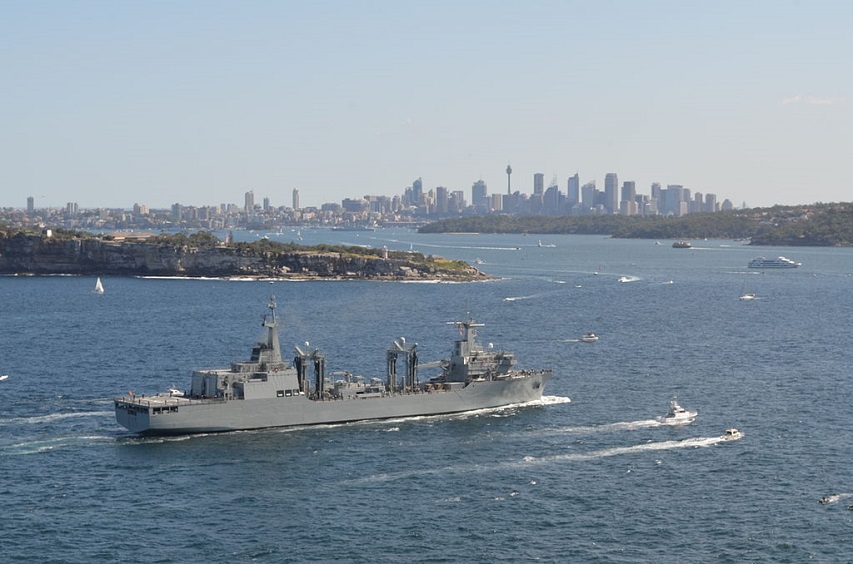Australia has similar military issues to the ones Canada faces, but unlike our own government (who view military spending primarily as the regional economic development variant of crony capitalism), Australia is amenable to economic sense when it comes to building the new support ships for the Royal Australian Navy:
The RAN is about to bring 3 large Hobart Class destroyers into service, but it’s the new LPD HMAS Choules and 2 Canberra Class 27,500t LHD amphibious assault ships that are going to put a real strain on the RAN’s support fleet. Liberal Party defense minister Sen. Johnson didn’t mince words when he announced the competition, early in their governing term:
“With the large LHD’s [sic] – 28,000 tonnes each – we must have a suitable replenishment ship to supply and support those vessels going forward, the planning for this should have been done a long, long time ago.”
The Australian government is explicit about needing “fuel, aviation fuel, supplies, provisions and munitions on these ships,” and they’ve short-listed 2 main competitors to build the ships outside of Australia:
Cantabria Class. The Cantabrias are an enlarged 19,500t version of the Patino Class replenishment ship. Fuel capacity rises to 8,920 m3 ship fuel and 1,585 m3 of JP-5 naval aviation fuel. Throw in 470t of general cargo, 280t of secured ammunition, and 215 m3 of fresh water to round out its wet/dry capabilities. These ships also carry a crew medical center with 10 beds, including operating facilities equipped for telemedicine by videoconference, an X-ray room, dental surgery, sterilization laboratory, and gas containment.Spain already uses this ship type, and Navantia S.A. is already building the Hobart Class and Canberra Class, giving them a deep relationship with Australian industry and the Navy.
Aegir Class. The government named Daewoo Shipbuilding and Marine Engineering (DSME), who are currently building Britain’s MARS 37,000t oiler/support ships based on BMT’s Aegir design. The concept is scalable, and Australia’s government sized the variant they’ve shortlisted at around 26,000t. BMT’s Aegir 26 design offers up to 19,000 m3 of cargo fuel, and 2-5 replenishment at sea stations for hoses and transfer lines. The design itself is somewhat customizable, so it will be interesting to see what the offer’s final specifications and features are.
Recall that HMAS Sirius was also built in South Korea, albeit in a different dockyard. That isn’t surprising, because South Korea arguably has the world’s best shipbuilding industry. Norway and Britain have each purchased customized versions of the Aegir Class ships.
Both the Royal Navy and the Royal Australian Navy are willing to buy ships from Korea. Why not the Royal Canadian Navy’s next ships? Because the government would rather spend many times more money and get smaller, less capable ships as long as they get to spread the money around to cronies:
They won’t be built in Australia, because the government doesn’t believe that the industrial infrastructure and experience is in place to build 20,000+ tonne ships locally. Britain has made a similar calculation, while Canada provides a cautionary example by building smaller supply ships locally at over 5x Britain’s cost.
H/T to Mark Collins for the link. Mark also posted this back in 2013:
To add insult to injury, the Royal Fleet Auxiliary, the civilian-manned support ships for the Royal Navy, are purchasing 4 replenishment vessels under the MARS tanker program to be built in South Korea by Daewoo (arguably the foremost shipbuilder in the world). These ships are slightly larger than the Berlin-class. What is the British government paying for these 4 vessels? £452M or about $686M USD. Not per ship but for all four. The per unit cost is around $170M. If we somehow manage to keep the cost for the JSS at $1.3B per unit, that will still be over 7.5x what the British are paying. If the cost goes up to ~$2B per JSS, we’re looking at almost 12x the cost [though the RCN’s JSS is supposed to have some additional capabilities (already much reduced from 2006 to now, and see the very optimistic timeline here) — but how many of them can the government afford?].





The government’s hands are tied by their own laws that were passed years ago to appease the media and other cry babies in the defence critique industry. Until they change the laws on Industrial Regional Benefits, and other Industry Canada laws with regards to large procurement projects, we are destined to continue to find ways to subsidize Canadian industries that don’t deserve to be subsidized.
And again, I quote from the web page of the IRB dept https://www.ic.gc.ca/eic/site/042.nsf/eng/home
“Canada’s Industrial and Regional Benefits (IRB) Policy ensures that Canadian industry benefit from Government defence and security procurement. The Policy requires companies that win defence and security contracts with the Government of Canada place business activities in Canada at the same value of the contract. This website details how the IRB Policy works and how Canadian companies can benefit.”
This is how they say it works:
https://www.ic.gc.ca/eic/site/042.nsf/eng/h_00041.html
Comment by Dwayne — June 9, 2014 @ 10:22